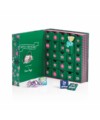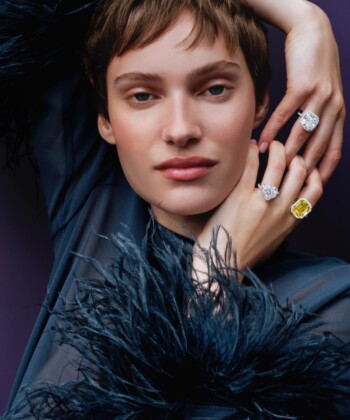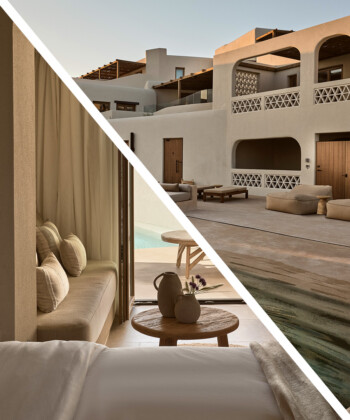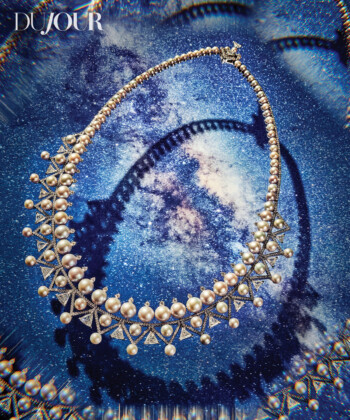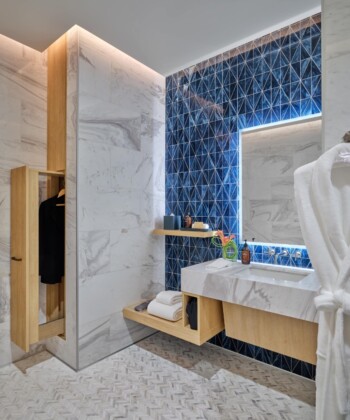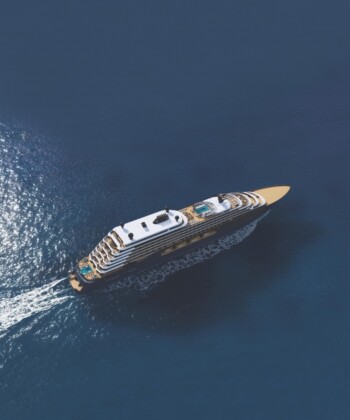It doesn’t matter how long one is in French Polynesia, it’s impossible to tire of the emerald blue-green waters so clear you can see the ocean floor below. It is this clarity that makes for some of the world’s best diving and snorkeling, and it’s the warmth of the waters that makes it an ideal farming ground for the coveted Tahitian black pearl.
The biggest generator of income in French Polynesia, only second to tourism, black pearls are ubiquitous on every populated island in the South Sea, the cultivation of pearls synonymous with modern island existence.

A view of the volcanic island landscape from Taha’a
During our seven-day sail through the Society Islands aboard Windstar Cruises, we visited the islands of Moorea, Taha’a, Raiatea, Bora Bora, Huahine, Papeete, Tahiti and several black pearl farms along the way. But to understand the preciousness of the black pearl we needed to get into the water where they grew.
From the dock where the Wind Spirit ship rested in Raiatea, we were transported to the western edge of the island. In the distance, approximately 500 yards offshore, where the waters are most pristine, sat a solitary hut resting on stilts over the water.
Anapa Perles general manager Summer Rotu stepped off a small marina skiff to greet us. She was striking in a long red dress, her blonde hair pulled back, exposing a neck adorned with large, perfectly round, multi-colored black pearls. (Contrary to popular belief, Tahitian blackpearls are not necessarily black—they come in shades of deep gray, blue, copper, yellow and beyond.)
We boarded the small boat and jetted to Anapa Perles. There, Summer walked us through the black pearl farming process. First they “sacrifice” a black-lipped oyster whose interior shell is the most beautiful they can find. By killing the oyster, they are able to graph the meat and place that material into a living oyster along with a small shell to instigate the production of the pearl. The inseminated pearl is then attached to the “rosary,” a long chain of oysters attached to a rope, and set back into the water for two years.

The hut approximately 500 yards offshore
Summer then let us loose on the coral reef to snorkel and experience a treasure hunt for our own black pearl. We tracked schools of fish in every color and swam in and out of the rosaries where hundreds of oysters were strung, working a sort of magic behind their shells. By the time we returned to the shack, the large oysters in hand, the late afternoon sun was dropping in the sky and nearby black-tipped sharks wriggled along the reef searching for food.
Wrapped in towels and sipping on cold Tahitian-made Hinano beer, Summer’s team opened our oysters. We didn’t know what we would find inside—it could be an exquisite pearl, a misshaped dud or it could be empty—the oyster rejecting the instigator altogether.
With a small clamp, the oyster was pried open just centimeters. A long, thin tool was inserted and slowly the pearl was guided out, gingerly navigated between the two sides of the shells. Out of the darkness appeared an extraordinary copper pearl.
To watch the pearl emerge from the cavity of the oyster we had plucked from the coral reef connected us to the pearl, the water, the people, place and experience—and gave us its gift of memorable beauty, something even hundreds of black pearl shops can never sell.






